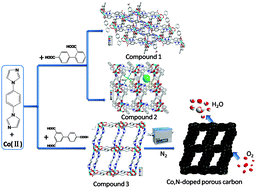Three 3D Co(ii) cluster-based MOFs constructed from polycarboxylate acids and bis(imidazole) ligands and their derivatives: magnetic properties and catalytic performance for the ORR†
Abstract
Three 3D polymeric complexes containing polynuclear Co(II) units, [Co3(bpda)3(bib)2]·H2O (1), [Co5(OH)2(H2O)2(bpda)4(bib)2]·2H2O (2), and [Co2(OH)(bib)(bpt)]·H2O (3) (H2bpda = biphenyl-2,4′-dicarboxylic acid, H3bpt = biphenyl-3,4′,5-tricarboxylic acid, bib = 1,4-bis(1-imidazolyl)benzene), have been prepared by urothermal synthesis. Complex 1 exhibits an unusual (4,6)-connected 3D network based on binuclear Co(II) clusters and Co2+ centers bridged by bpda2− and bib ligands. Complex 2, containing a novel pentanuclear Co(II) cluster, features a porous 3D MOF with a regular nanosized tunnel. Complex 3 contains an interesting tetranuclear Co(II) cluster and displays an amazing 3D porous MOF built from double-layered 2D [Co2(μ3-OH)(bpt)3]n networks pillared by two rows of bib spacers. In the title complexes, polycarboxylate acids serve to construct and stabilize the polynuclear Co(II) clusters, while bis(imidazole)s help to expand the dimensionality of MOFs. Complexes 2 and 3 show antiferromagnetic properties. Compound 3 with high surface area, high yield, high purity, and high chemical stability was used as a precursor to fabricate Co,N-codoped porous carbon materials by simple carbonization under an Ar atmosphere. The catalytic properties of the Co,N-codoped porous carbon material derived from complex 3 (denoted as CoNC-3) as an ORR electrocatalyst were studied. CoNC-3 displays superior electrocatalytic performances for the ORR.



 Please wait while we load your content...
Please wait while we load your content...